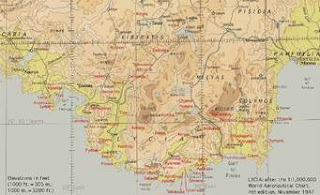CARTOGRAPHY AND MAP PROJECTION

CARTOGRAPHY, Cartography is an art or a science of designing a map to represent either the whole or any part of the earth s surface in scaled and conventional form. There are noticeable contrasts between maps and the whole or parts of the earth s surface represented as follow- - Map is flat, while the earth s surface or part of the earth s surface is not flat. Maps are much smaller in size, while the whole earth or a part of the earth represented is much larger in size With this the map makers use a cartographic technique to maintain the accuracy of the earth s shape and size on maps. The technique is known as map projection It is thus: the cartographic technique is associated with map projection. It is thus: the cartographic technique is associated with map projection as a sole means of maintaining accuracy of areas on maps.
>>>A person responsible in map making is called CARTOGRAPHER.
MAP PROJECTION, The earth s surface can be wholly represented with reasonable accuracy on a globe But globes are not as convenient as flat maps to use. Globe cannot depicts much details like transportation system of a cite, or the location of very small towns or villages. With this, maps have to be produced to facilitate geographical studies. To make the maps so accurate, a cartographic technique of map projection is defined as the cartographic technique of transforming the shape of the earth's surface or part of the earth's surface more accurately- to a plane surface to develop a map that can be easily worked with less distortion, i.e It is the cartographic technique of maintaining the accuracy of an area on a map The cartographic technique of map projection is recognized be of varied types as flat bodies into which maps developed differently projected. This develops cylindrical, conical and plane map projections The cartographic technique of map projection is recognized be of varied types as flat bodies onto which maps developed differently projected. This develops cylindrical, conical and plane map projections. More over; on a map, the features are made to have accuracy on different respects. This also develops the types of map projection which are like as follows;
Cylindrical projection, By cylindrical projection, the shape of the earth s surface is accurately maintained as a frat body onto which a map would be drawn, projected to a shape of the earth s surface is maintained and then the cylindrical projected body is cut to develop flat map onto which the whole earth surface appears Cylindrical projection is alternatively known as mercators projection
Conical projection, It is a considerable form of map projection. by which, the shape of the earth s surface is accurately maintained as a flat body onto which a map would be drawn is projected to a conical shape. Over the surface of projected conical body, the shape of the earth s surface is maintained then the conical body is cut to develop a flat map onto which the whole earth s surface or part of the earth surface appears.
Plane projection, By plane projection. the area particularly of a limited size whose accuracy is directly maintained on a flat body as a piece of paper

Azimuthal projection, It is a type of map projection which mostly used to maintain the correct distribution of the surface features on a map by being maintained in true directions and distance relatively to one another with reference from the centre of a map and up on the actual area on the earth s surface By this, all bearings are laid off correctly from the central point of the map. so that all points on the map and up on the area on the earth s surface are true in distance and direction from the centre.
Gnomic projection, It is alternatively known as equi-distance projection. This is used to maintain the accuracy of ground distances on the map with respect to the used scale by regarding the relative bearing of the features in the area.
Streographic, projection It is a cartographic technique of preserving the correct shape of earth s surface features on a map Preservation of the features is maintained by taking into consideration of the satellite images and aerial photographs.
FACTORS INFLUENCING CARTOGRAPHIC PROCESS (KEY ISSUES CONSIDERED IN MAP MAKING)
I n a process of map making a present a certain part of the earth s surface, the following should be taken into consideration as guides to map maker.
• The size of the actual area to be represented on a map The size of the area is revealed by making survey or by examining the vertical photograph that represents the same area
• Size of the plane surface of a piece of paper onto which a map would be designed
• Map scale. The scale is determined by relating the corresponding distance between the map and ground Scale is what determines the amount of details about the area appear on the map.
• Methods of projection as means of maintaining the accuracy of the map.
• Nature and amount of the features to be shown on a map. This largely depends on a type of map would be designed under plan and chosen scale size
PROCEDURES FOR MAP MAKING........................................

Comments
Post a Comment